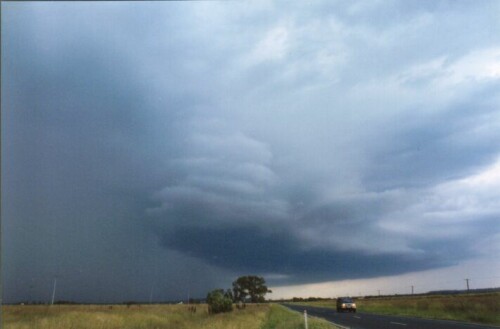
Supercellular Shear Shear is quite a diverse subject when you look
into it quite deeply. There's another concept (and it's often thought
to be quite a critical concept for supercells, especially in the US - although
in Australia you'll probably find that storms don't require it *quite*
as much). Anyway...directional shear, what do I mean by that?
Remember when we looked at Skew-Ts, we could see the wind strengths and
directions of the winds above that point. Essentially, in the southern
hemisphere, you want the shear to back (turn anti-clockwise with height).
In the northern hemisphere, you want the shear to veer (turn clockwise
with height). For example, the southern hemisphere might have a shear
profile like this:
Why do we need it? Well, stretching of an updraft already provides some vorticity, but further vorticity can be enhanced by directional shear, for instance a diagram of what this might look like:
This might help conceptualise how directional shear can help with updrafts. Of course, this then helps develop supercells (which is simply defined by the presence of a sustained mesocyclone, and a mesocyclone is simply a rotating updraft!) Here's a photo of the January 25, 1999 Oakey supercell I took from the Warrego Hwy, you can see the rotation and wrapping around in the updraft! It's one of the best examples of a mesocyclone I've personally seen to date (physically).
So how much is needed? Well...normally it's taken over the lower 6km (say surface-500mb). The threshold for supercellular development is thought to be 90 degrees (eg, NE to NW). Anything further is a bonus, and 180 degrees is considered ideal (but in my experience, rarely achieved). But generally most shear will back NE to at least NW, and often even further towards the W by 500mb. I once was fortunate enough to attend a presentation by Harald Richter who discussed the concept of "0-6km shear strength." Essentially, it seems that the stronger the shear is - the less you need it to back with height. Harald mentioned that the 0-6km shear should be 40 knots. What does this mean? Well, lets say there is a NE'ly at the surface of 10 knots. Lets then say that at 500mb, the winds are from the SW at 35 knots. Because they are exactly 180 degrees from each other, add them up and you get 45 knots, which is within the threshold for supercellular shear. What about if you have a 10 knot NW'ly, and at 500mb it's 50 knots NW'ly too? Because the shear is all in the same direction, you don't get any "bonuses" here - but the 0-6km shear is considered to be 50-10 knots, which is 40 knots and is the threshold. It's a bit tricky to get your head around, but from my experience it does seem to be a fairly accurate threshold. There isn't much more to say except how this might look like on a Skew-T, but I think that the case study for this part will explain this well! |


